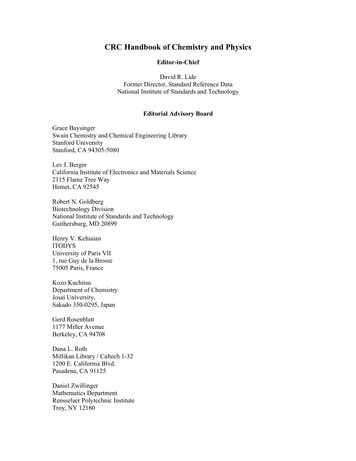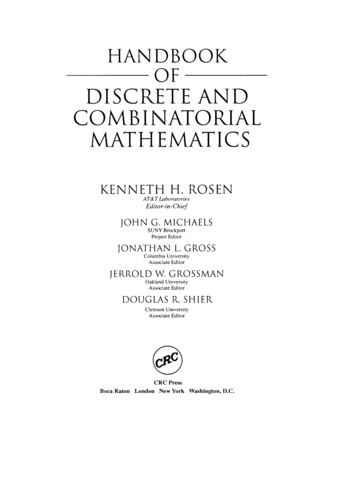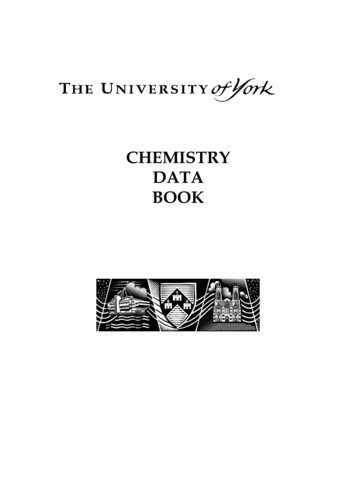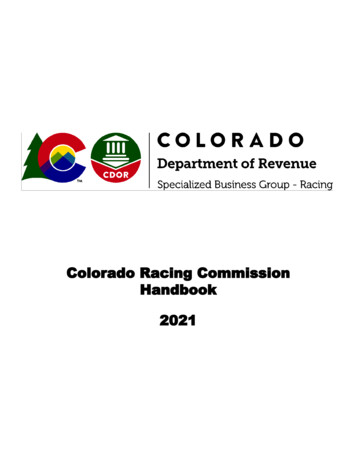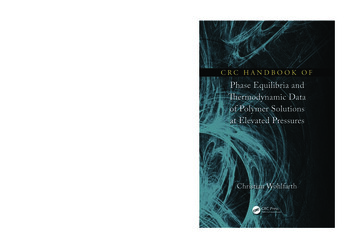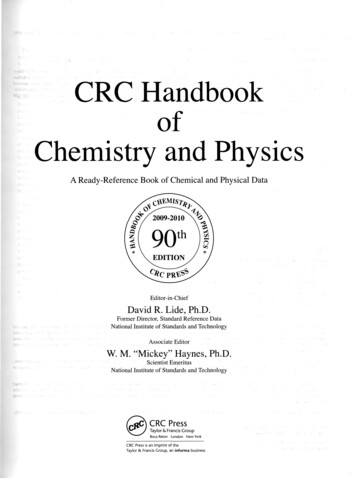
Transcription
CRC HandbookofChemistry and PhysicsA Ready-Reference Book of Chemical and Physical DataEditor-in-ChiefDavid R. Lide, Ph.D.Former Director, Standard Reference DataNational Institute of Standards and TechnologyAssociate EditorW. M. "Mickey" Haynes, Ph.D.Scientist EmeritusNational Institute of Standards and TechnologyLßP) CRC Press JTaylor & Francis GroupBoca Raton London New YorkCRC Press is an imprint of theTaylor & Francis Group, an informa business
h TABLE OF CONTENTS.SECTION 1: BASIC CONSTANTS, UNITS, A N D CONVERSION FACTORSCODATA Recommended Values of the Fundamental Physical ConstantsStandard Atomic Weights (2008)Atomic Masses and AbundancesElectron Configuration and Ionization Energy of Neutral Atoms in the Ground StateInternational Temperature Scale of 1990 (ITS-90)Conversion of Temperatures from the 1948 and 1968 Scales to ITS-90International System of Units (SI)Units for Magnetic PropertiesConversion FactorsConversion of TemperaturesConversion Factors for Energy UnitsConversion Factors for Pressure UnitsConversion Factors for Thermal Conductivity UnitsConversion Factors for Electrical Resistivity UnitsConversion Factors for Chemical KineticsConversion Factors for Ionizing RadiationValues of the Gas Constant in Different Unit 1-401-411-421-431-441-46.'.SECTION 2: SYMBOLS, TERMINOLOGY, A N D NOMENCLATURESymbols and Terminology for Physical and Chemical QuantitiesExpression of Uncertainty of MeasurementsNomenclature for Chemical CompoundsNomenclature for Inorganic Ions and LigandsOrganic Substituent Groups and Ring SystemsRepresentation of Chemical Structures with the IUPAC International Chemical Identifier (InChl)Scientific Abbreviations, Acronyms, and SymbolsGreek, Russian, and Hebrew AlphabetsDefinitions of Scientific TermsThermodynamic Functions and RelationsNobel Laureates in Chemistry and 2-69SECTION 3: PHYSICAL CONSTANTS OF ORGANIC C O M P O U N D SPhysical Constants of Organic CompoundsSynonym Index of Organic CompoundsMolecular Formula Index of Organic CompoundsCAS Registry Number Index of Organic CompoundsDiamagnetic Susceptibility of Selected Organic Compounds3-13-5243-5493-6343-672SECTION 4: PROPERTIES OF THE ELEMENTS A N D INORGANIC C O M P O U N D SThe ElementsPhysical Constants of Inorganic CompoundsFormula Index of Inorganic CompoundsCAS Registry Number Index of Inorganic CompoundsPhysical Properties of the Rare Earth MetalsMelting, Boiling, Triple, and Critical Point Temperatures of the ElementsHeat Capacity of the Elements at 25 CVapor Pressure of the Metallic Elements — EquationsVapor Pressure of the Metallic Elements — DataDensity of Molten Elements and Representative SaltsMagnetic Susceptibility of the Elements and Inorganic CompoundsIndex of Refraction of Inorganic LiquidsPhysical and Optical Properties of MineralsCrystallographic Data on 4-1394-1424-1484-1494-156SECTION 5: THERMOCHEMISTRY, ELECTROCHEMISTRY, A N D KINETICSCODATA Key Values for ThermodynamicsStandard Thermodynamic Properties of Chemical SubstancesThermodynamic Properties as a Function of Temperature,5-15-45-43
Thermodynamic Properties of Aqueous IonsHeat of CombustionEnergy Content of FuelsElectrical Conductivity of WaterElectrical Conductivity of Aqueous SolutionsStandard KCl Solutions for Calibrating Conductivity CellsMolar Conductivity of Aqueous HF, HCl, HBr, and HIEquivalent Conductivity of Electrolytes in Aqueous SolutionIonic Conductivity and Diffusion at Infinite DilutionActivity Coefficients of Acids, Bases, and SaltsMean Activity Coefficients of Electrolytes as a Function of ConcentrationEnthalpy of Dilution of AcidsEnthalpy of Solution of ElectrolytesEnthalpy of Hydration of GasesChemical Kinetic Data for Stratospheric ModelingSECTION 6: FLUID PROPERTIESThermophysical Properties of Water and SteamVapor Pressure and Other Saturation Properties of WaterStandard Density of WaterFixed Point Properties of H 2 0 and D 2 0Properties of Saturated Liquid D 2 0Properties of Ice and Supercooled WaterVapor Pressure of IceMelting Point of Ice as a Function of PressurePermittivity (Dielectric Constant) of Water at Various FrequenciesThermophysical Properties of AirThermophysical Properties of FluidsVirial Coefficients of Selected GasesVan der Waals Constants for GasesMean Free Path and Related Properties of Gasesi Influence of Pressure on Freezing PointsCritical ConstantsSublimation Pressure of SolidsVapor PressureVapor Pressure of Fluids at Temperatures below 300 КVapor Pressure of Saturated Salt SolutionsIUPAC Recommended Data for Vapor Pressure CalibrationEnthalpy of VaporizationEnthalpy of FusionPressure and Temperature Dependence of Liquid DensityVolumetric Properties of Aqueous Sodium Chloride SolutionsProperties of Cryogenic FluidsProperties of Liquid HeliumProperties of RefrigerantsProperties of Gas Clathrate HydratesIonic LiquidsDensity and Specific Volume of MercuryThermal Properties of MercuryMelting Curve of MercuryVapor Pressure of MercurySurface Tension of Common LiquidsSurface Tension of Aqueous MixturesPermittivity (Dielectric Constant) of LiquidsPermittivity (Dielectric Constant) of GasesAzeotropic Data for Binary MixturesViscosity of GasesViscosity of LiquidsViscosity of Carbon Dioxide along the Saturation LineViscosity and Density of Aqueous Hydroxide SolutionsViscosity of Liquid MetalsThermal Conductivity of GasesThermal Conductivity of 086-2096-2146-2156-2166-2186-220
Diffusion in GasesDiffusion of Gases in WaterDiffusion Coefficients in Liquids at Infinite Dilution,SECTION 7: BIOCHEMISTRYProperties of Amino AcidsStructures of Common Amino AcidsProperties of Purine and Pyrimidine BasesThe Genetic CodeProperties of Fatty Acids and Their Methyl EstersComposition and Properties of Common Oils And FatsCarbohydrate Names and SymbolsStandard Transformed Gibbs Energies of Formation for Biochemical ReactantsApparent Equilibrium Constants for Enzyme-Catalyzed ReactionsThermodynamic Quantities for the Ionization Reactions of Buffers in WaterBiological BuffersTypical pH Values of Biological Materials and FoodsStructure and Functions of Some Common DrugsChemical Constituents of Human BloodChemical Composition of the Human BodyNutrient Values of FoodsSECTION 8: ANALYTICAL CHEMISTRYPreparation of Special Analytical ReagentsStandard Solutions of Acids, Bases, and SaltsStandard Solutions of Oxidation and Reduction ReagentsOrganic Analytical Reagents for the Determination of Inorganic SubstancesFlame and Bead TestsAcid-Base IndicatorsFluorescent IndicatorsConversion Formulas for Concentration of SolutionsElectrochemical Series,Reduction and Oxidation Potentials for Certain Ion RadicalspH Scale for Aqueous SolutionsPractical pH Measurements on Natural WatersBuffer Solutions Giving Round Values of pH at 25 CDissociation Constants of Inorganic Acids and BasesDissociation Constants of Organic Acids and BasesConcentrative Properties of Aqueous Solutions: Density, Refractive Index, Freezing Point Depression, and ViscosityIon Product of Water SubstanceIonization Constant of Normal and Heavy WaterSolubility of Selected Gases in WaterSolubility of Carbon Dioxide in Water at Various Temperatures and PressuresAqueous Solubility and Henry's Law Constants of Organic CompoundsAqueous Solubility of Inorganic Compounds at Various TemperaturesSolubility Product ConstantsSolubility of Common Salts at Ambient TemperaturesSolubility of Hydrocarbons in SeawaterSolubility of Organic Compounds in Pressurized Hot WaterSolubility ChartReduction of Weighings in Air to VacuoVolume of One Gram of WaterProperties of Carrier Gases for Gas ChromatographySolvents for Ultraviolet Spectrophotometry13C Chemical Shifts of Useful NMR SolventsMass Spectral Peaks of Common Organic SolventsProton NMR Shifts of Common Organic SolventsSECTION 9: MOLECULAR STRUCTURE A N D SPECTROSCOPYBond Lengths in Crystalline Organic CompoundsBond Lengths in Organometallic CompoundsStructure of Free Molecules in the Gas 1408-1418-1428-1438-1509-19-179-19
Characteristic Bond Lengths in Free MoleculesAtomic Radii of the ElementsDipole MomentsHindered Internal RotationBond Dissociation EnergiesElectronegativityForce Constants for Bond StretchingFundamental Vibrational Frequencies of Small MoleculesSpectroscopic Constants of Diatomic MoleculesInfrared Correlation ChartsNuclear Spins, Moments, and Other Data Related to NMR SpectroscopyProton NMR Chemical Shifts for Characteristic Organic Structures13C-NMR Absorptions of Major Functional GroupsSECTION 10: ATOMIC, MOLECULAR, A N D OPTICAL PHYSICSLine Spectra of the ElementsNIST Atomic Transition ProbabilitiesElectron AffinitiesProton AffinitiesAtomic and Molecular PolarizabilitiesIonization Energies of Atoms and Atomic IonsIonization Energies of Gas-Phase MoleculesX-Ray Atomic Energy LevelsElectron Binding Energies of the ElementsNatural Width of X-Ray LinesPhoton Attenuation CoefficientsClassification of Electromagnetic RadiationSensitivity of the Human Eye to Light of Different WavelengthsBlack Body RadiationCharacteristics of Infrared DetectorsIndex of Refraction of Inorganic CrystalsRefractive Index and Transmittance of Representative GlassesIndex of Refraction of WaterIndex of Refraction of Liquids for Calibration PurposesIndex of Refraction of AirIndex of Refraction of GasesCharacteristics of Laser SourcesInfrared Laser FrequenciesInfrared and Far-Infrared Absorption Frequency StandardsSECTION 11: NUCLEAR A N D PARTICLE PHYSICSSummary Tables of Particle PropertiesTable of the IsotopesNeutron Scattering and Absorption PropertiesCosmic RadiationSECTION 12: PROPERTIES OF SOLIDSTechniques for Materials CharacterizationSymmetry of CrystalsIonic Radii in CrystalsPolarizabilities of Atoms and Ions in SolidsCrystal Structures and Lattice Parameters of Allotropes of the ElementsPhase Transitions in the Solid Elements at Atmospheric PressureLattice EnergiesThe Madelung Constant and Crystal Lattice Energy:,, Elastic Constants of Single CrystalsElectrical Resistivity of Pure MetalsElectrical Resistivity of Selected AlloysElectrical Resistivity of Graphite MaterialsPermittivity (Dielectric Constant) of Inorganic SolidsCurie Temperature of Selected Ferroelectric CrystalsProperties of Antiferroelectric CrystalsDielectric Constants of 2-5712-58
Properties of SuperconductorsHigh-Temperature SuperconductorsOrganic SuperconductorsProperties of SemiconductorsSelected Properties of Semiconductor Solid SolutionsProperties of Organic SemiconductorsDiffusion Data for SemiconductorsProperties of Magnetic MaterialsOrganic MagnetsElectron Inelastic Mean Free PathsElectron Work Function of the ElementsSecondary Electron EmissionOptical Properties of Selected Elements,Optical Properties of Selected Inorganic and Organic SolidsElasto-Optic, Electro-Optic, and Magneto-Optic ConstantsNonlinear Optical ConstantsPhase DiagramsHeat Capacity of Selected SolidsThermal and Physical Properties of Pure MetalsThermophysical Properties of Stainless Steel 310Thermal Conductivity of Metals and Semiconductors as a Function of TemperatureThermal Conductivity of Alloys as a Function of TemperatureThermal Conductivity of Crystalline DielectricsThermal Conductivity of Ceramics and Other Insulating MaterialsThermal Conductivity of Glasses,Thermoelectric Properties of Metals and SemiconductorsFermi Energy and Related Properties of MetalsProperties of Commercial Metals and AlloysHardness of Minerals and CeramicsSECTION 13: POLYMER PROPERTIESNomenclature for Organic PolymersSolvents for Common PolymersGlass Transition Temperature for Selected PolymersDielectric Constant of Selected PolymersPressure-Volume-Temperature Relationship for Polymer MeltsUpper Critical (UCST) and Lower Critical (LCST) Solution Temperatures of Binary Polymer SolutionsVapor Pressures (Solvent Activities) for Binary Polymer SolutionsSpecific Enthalpies of Solution of Polymers and CopolymersSolubility Parameters of Selected 3-1913-3713-4213-70SECTION 14: GEOPHYSICS, ASTRONOMY, AND ACOUSTICSAstronomical ConstantsProperties of the Solar SystemSatellites of the PlanetsInterstellar MoleculesMass, Dimensions, and Other Parameters of the EarthGeological Time ScaleAcceleration Due to GravityDensity, Pressure, and Gravity as a Function of Depth Within the EarthOcean Pressure as a Function of Depth and LatitudeProperties of SeawaterAbundance of Elements in the Earth's Crust and in the SeaSolar Spectral IrradianceU.S. Standard Atmosphere (1976)Geographical and Seasonal Variation in Solar RadiationMajor World EarthquakesWeather-Related ScalesInfrared Absorption by the Earth's AtmosphereAtmospheric Concentration of Carbon Dioxide, 1958-2004Mean Temperatures in the United States, 1900-1992Global Temperature Trend, 1856-2004Global Warming Potential of Greenhouse 814-39
Atmospheric ElectricitySpeed of Sound in Various MediaAttenuation and Speed of Sound in Air as a Function of Humidity and FrequencySpeed of Sound in Dry AirMusical ScalesCharacteristics of Human HearingSECTION 15: PRACTICAL LABORATORY DATAStandard ITS-90 Thermocouple TablesSecondary Reference Points on the ITS-90 Temperature ScaleRelative Sensitivity of Bayard-Alpert Ionization Gauges to Various GasesLaboratory Solvents and Other Liquid ReagentsMiscibility of Organic SolventsDensity of Solvents as a Function of TemperatureDependence of Boiling Point on PressureEbullioscopic Constants for Calculation of Boiling Point ElevationCryoscopic Constants for Calculation of Freezing Point DepressionFreezing Point Lowering by Electrolytes in Aqueous SolutionCorrection of Barometer Readings to 0 C TemperatureDetermination of Relative Humidity from Dew PointDetermination of Relative Humidity from Wet and Dry Bulb TemperaturesConstant Humidity SolutionsStandard Salt Solutions for Humidity CalibrationLow-Temperature Baths for Maintaining Constant TemperatureMetals and Alloys with Low Melting TemperatureWire TablesCharacteristics of Particles and Particle DispersoidsDensity of Various SolidsDensity of Sulfuric AcidDensity of Ethanol-Water MixturesDielectric Strength of Insulating MaterialsCoefficient of FrictionFlame TemperaturesAllocation of Frequencies in the Radio 115-4215-4715-4915-50SECTION 16: HEALTH A N D SAFETY INFORMATIONHandling and Disposal of Chemicals in LaboratoriesFlammability of Chemical SubstancesThreshold Limits for Airborne ContaminantsOctanol-Water Partition CoefficientsProtection against Ionizing RadiationAnnual Limits on Intakes of RadionuclidesChemical DIX A: MATHEMATICAL TABLESMiscellaneous Mathematical ConstantsDecimal Equivalents of Common FractionsQuadratic FormulaExponential and Hyperbolic Functions and Their Common LogarithmsNatural Trigonometric Functions to Four PlacesRelation of Angular Functions in Terms of One AnotherDerivativesIntegrationIntegralsDifferential EquationsFourier SeriesFourier Expansions for Basic Periodic FunctionsThe Fourier TransformsSeries ExpansionVector AnalysisOrthogonal Curvilinear CoordinatesTransformation of IntegralsBessel A-61A-65A-68.A-75A-77A-78
The Factorial FunctionThe Gamma FunctionThe Beta FunctionThe Error FunctionOrthogonal PolynomialsTables of Orthogonal PolynomialsClebsch-Gordan CoefficientsNormal Probability FunctionPercentage Points, Student's -DistributionPercentage Points, Chi-Square DistributionPercentage Points, F-DistributionMoment of Inertia for Various Bodies of 97APPENDIX B: SOURCES OF PHYSICAL A N D CHEMICAL DATAB-lINDEX1-1
CRC Handbook of Chemistry and Physics A Ready-Reference Book of Chemical and Physical Data Editor-in-Chief David R. Lide, Ph.D. Former Director, Standard Reference Data National Institute of Standards and Technology Associate Editor W. M. "Mickey" Haynes, Ph.D. Scientist Emeritus National Institute of
